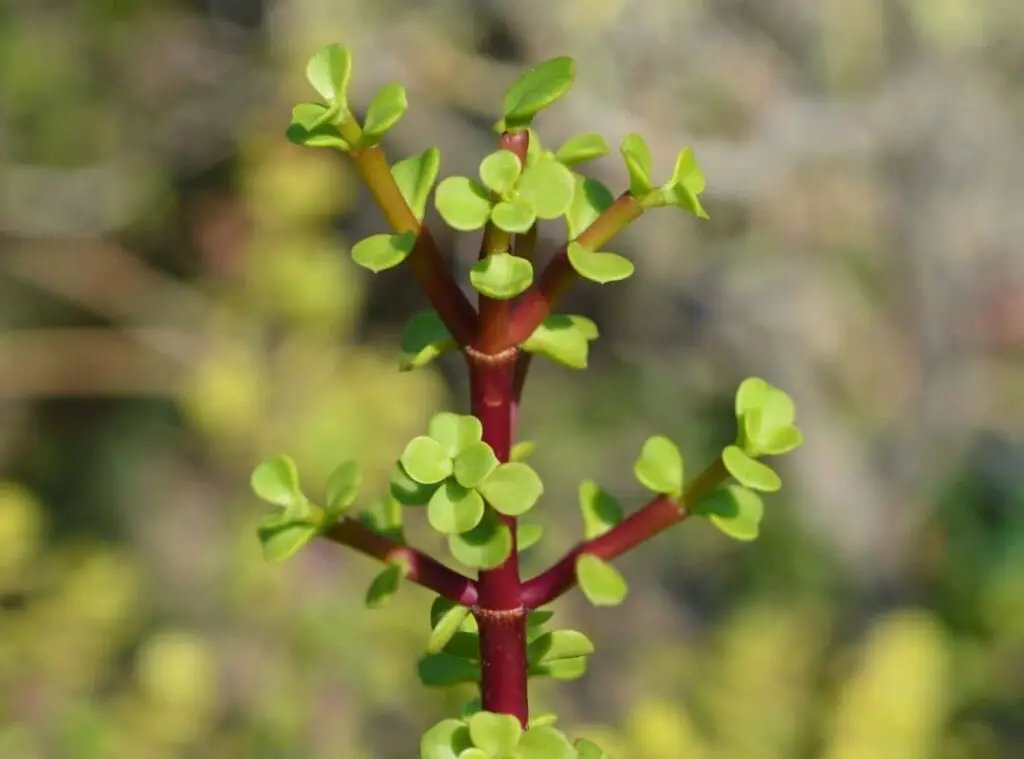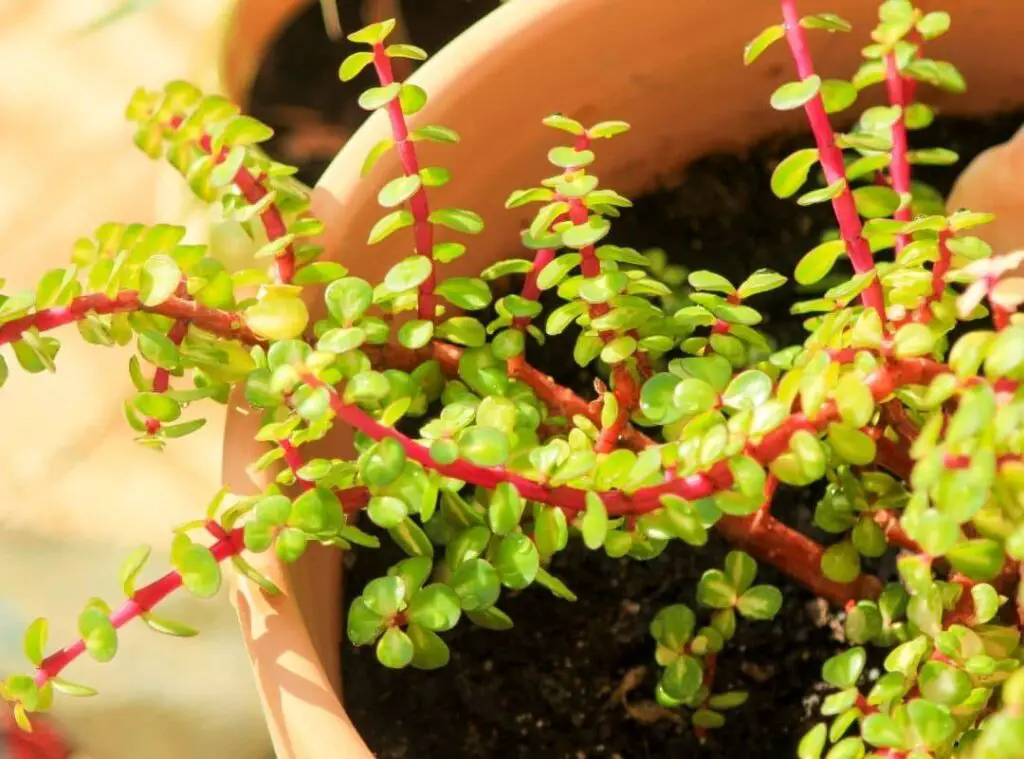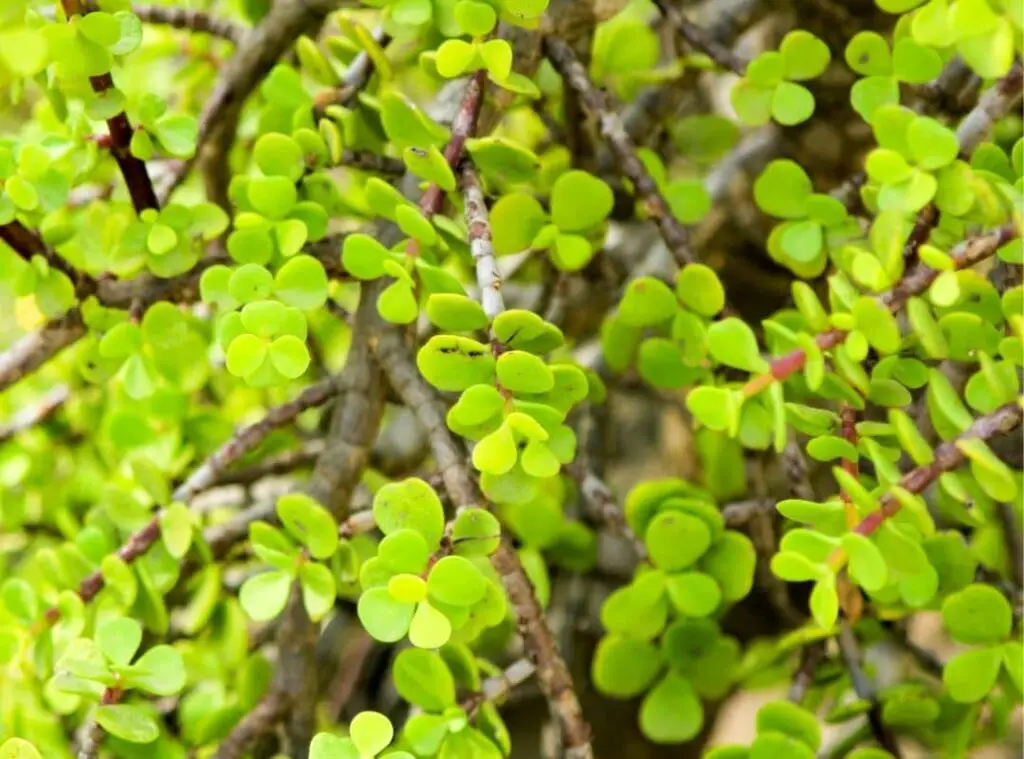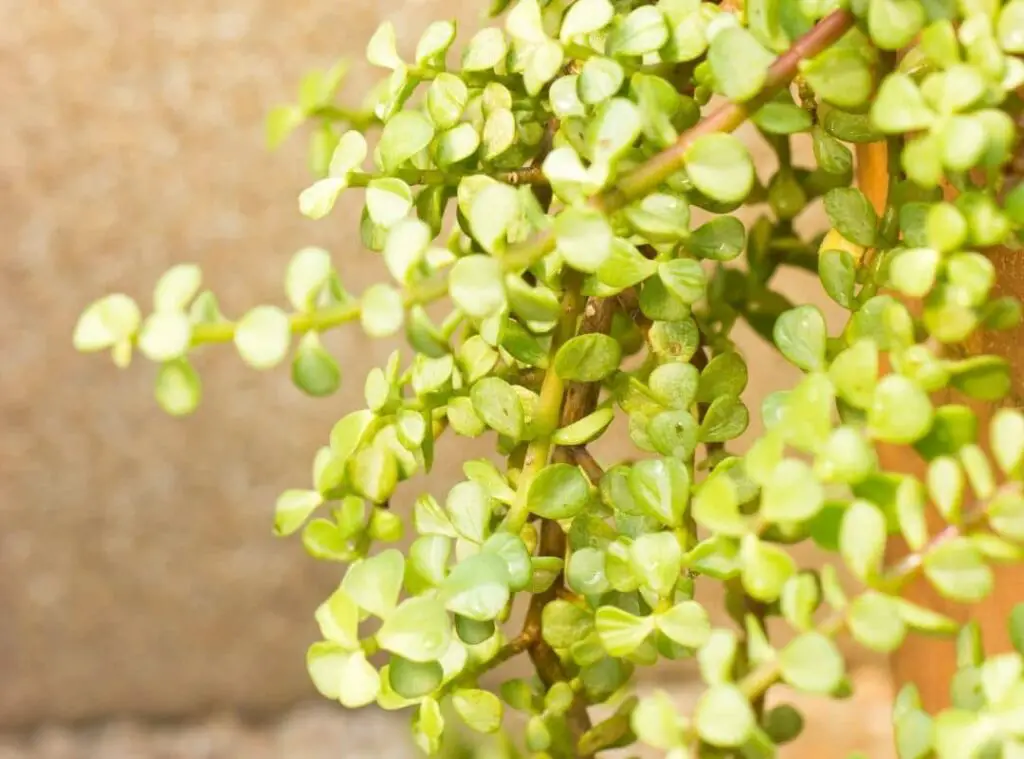Miniature Jade or Elephant bush plant’s scientific name is Portulacaria afra. This is a native plant in South Africa. This is an attractive plant which is suitable for both indoor and outdoor gardens.
Though Many people call it a miniature Jade it has no connection with Crassula ovata (jade plant) plants.
We can spot elephant bush succulents in both miniature and variegated forms. Further The non-variegated version of elephant bush can tolerate more heat conditions.
Elephant bush is commonly used for bonsai. Further, asia elephants eat elephant bush succulents in their natural habitats. This could be commonly seen in South Africa.
This plant requires minimum care treatment and tends to grow well in locations where they get proper sunlight.
Their dwarf version will be quite handy to use as a ground cover. We could use this as a plant for xeriscaping since it could bear minimum watering.

How do I identify an elephant bush?
Elephant bush has similarities to Jade plants. However Elephant bush succulent has a reddish brown stem.
Further their leaves are shiny and rounded shaped. Moreover you could spot variegated and fleshy leaves in Elephant bush
Elephant bush is a slow growing plant. However once the stem matures, they get thick and carry an old look even though they are not really old.
These plants have a cascading nature. Hence, many people would love to grow them in hanging containers. Usually they will stay evergreen. It will be handy in using screens and for hedging.
Size
If the elephant bush succulents are grown in their natural habitat, they could be six to twenty feet tall.
On the other hand, they will be about one meter tall ( about 4 feet ) when we have grown them indoors.
The stem would also rise up to 8 – 15 feet high.
Growth
Elephant bush succulents grow well if we can give them dry slopes with rock surfaces.
On the other hand, chances are that they would continue to be a tiny plant while being only a few feet in height.
One look care guide
| Botanical Name | Portulacaria afra. |
| Common Name | Elephant bush, miniature Jade |
| Plant Type | Succulent plant |
| Mature Size | 20 feet tall |
| Sun Exposure | Full sunlight to partial sunlight |
| Soil Type | Well-draining |
| Soil pH | moderately or slightly acid, neutral, or slightly alkaline. |
| Bloom Time | Late Spring or early summer |
| Flower Color | pink white or purple color blooms |
| Hardiness Zones | USDA 9-11 zones |
| Native Area | South Africa |
| Toxicity | Non toxic |
| Average price | 12 – 18 USD |

12 Care Tips
Light Requirement
Elephant bush would want bright sunlight along with much warmer conditions to survive
Therefore, we could plant them in a place where they get either bright sunlight or partial sunlight. Six hours of bright sunlight would be adequate for them for a day.
If you have to move the plant from indoors to outdoors where we expose the plants to direct sunlight at once, their leaves will burn. Consequently, they will shed their leaves too.
Hence, the safest thing to do is to provide them with partial bright sunlight or filtered sunlight.
Temperature and humidity
Elephant bush can withstand mild frost conditions as well as colder temperatures up to 25 degrees Fahrenheit. However, they could handle mild frost conditions only for a short period of time.
Consider that you live in an area where it will have to go through freezing temperatures. Then the best thing to do is to grow elephant bush in containers.
If you grow them in containers, you can easily relocate them indoors to protect them from extreme colder conditions.

Is it cold hardy?
Elephant bush succulent is not cold hardy Hence if you are someone who lives in an area where the temperature gets dropped to 25 degrees Fahrenheit or more , you should grow them in containers or in pots. As such you could easily bring them indoors.
USDA hardiness zone
Their preferred USDA hardiness zones would be 10-11. They would do well in those conditions.
Pot size Potting and Repotting
First , you should water your elephant bush succulent a few days prior to repotting, as you don’t want the plant to be in stress during the repotting.
Secondly, You could easily pull out and take the elephant bush plant out , when you turn the upside down while squeezing the sides.
Thirdly, You could add succulent and cactus mix into the potting soil at the base of the pot. That will help the root ball to be equal with the top.
Finally, Try adding some pumice into the mix and fill the pot. Further you can put some worm compost and a little amount for regular compost on to the top of the pot also for better results.
Place it near a front door where it will get adequate sunlight. Let the plant establish in their new homes for about one week. Then you can start watering appropriately and thoroughly.
Where to Plant
Elephant bush succulent is not a cold hardy plant.
Hence if you are someone who lives in an area where the temperature drops to 30 degrees Fahrenheit or more ,you should grow them in containers or in pots. As such you could easily bring them indoors.
It could thrive in full sunlight to partial sunlight. Wherever you select to plant it, you should provide six hours of bright sunlight for them and for the rest of the day you can keep them under partial sunlight.
If you consider growing them indoors, you could locate them near a sunny window. They could also stretch to a certain direction if they lack sunlight.
However, you cannot spot thi significantly like with other succulents.
Fertilizer and time of year
You could apply fertilizers during early springtime or even in late winter. Further We can use a diluted indoor plant fertilizer. It should be ideally diluted by half.

Dormancy
Elephant bush plants are winter dormant plants. You should refrain from watering during their dormant season. Further you should avoid doing the Propagation also during this season.
Other plants Pairs Well With
It could pair well with the Graptosedum ‘California Sunset’ plant.
Elephant bush succulents would perform well in a succulent display along with other succulents who would need the same requirements and the care treatment.
Can it be toxic to pets?
They are non toxic to pets. Furthermore, they are not toxic to humans as well. If you wish you could eat ‘Elephant Bush’ foliage.
Common bugs and illnesses
Mealy bugs could attack the Elephant bush succulents. You could spot them in tiny, cottony patches on the surfaces of the green leaves.
Further you could treat them by simply wiping it off whilst using a cotton swab. You should use it after it is dipped in alcohol.
Apart from mealy bugs, be on alert for pests like spider mites and for whiteflies.
In addition to the pest issues, one more major illness issue with elephant bushes are leaf dropping and their leaves turning yellow. This mainly happens due to issues related to watering.
Further, make sure that you do not let the soil be in wet conditions. On the other hand, don’t keep soil dry for too long too. Both could badly affect the plant.
Read More: Why Do Snake Plant Leaves Turn Yellow? Explained With 10 Reasons
Special Care tips
We need to provide the same care treatment we do for other succulents for elephant bush succulent as well.
If you consider an elephant bush plant which you have grown outdoors, you could add sand consequently which will make the draining in the soil efficient.
Be on alert for pests and take necessary actions as soon as you notice them. Be moderate in watering and ensure that you don’t over water the elephant bush plants. Refrain watering in their dormant season.
Avoid keeping the outdoor grown elephant bush succulents in wet conditions. Furter Do fertilize as appropriate during the recommended seasons.

Elephant bush losing leaves and causes
Issues related to watering is the main reason for the elephant bush plants to lose their leaves.Both Under watering as well as over watering could cause this.
If we consider a drought condition or an under watering condition, the plant will start to drop its leaves in order to protect its stored water.
They have structured naturally for that and it is a natural survival process.
If you realize that your elephant bush plant is dropping its leaves due to this, you should start watering them as fast as you can. But do not over water them.
They will tend to drop their leaves when you have over-watered the plants. When your plant is underwater their leaves will be dry.
Further you could see them as shriveled. On the other hand, when you have over-watered your plant, leaves will be mushy and soft.
You should immediately suspend in watering at this point of time
Related Questions
Is elephant bush an indoor plant?
You could grow this as an indoor plant. If you plant the elephant bush plant indoors, it will continue to grow a few feet in height.
Home indoor greenery landscape would be an ideal place to grow elephant bush plants.
Is elephant bush toxic?
They are not toxic to any domestic pets and to humans.
Do elephant bushes need direct sunlight?
They do not want direct sunlight, but Elephant bush would want bright sunlight to thrive.
Therefore, we could plant them in a place where they get either bright sunlight or partial sunlight.
You should provide six hours of bright sunlight for them and for the rest of the day you can keep them under partial sunlight.
Read More: String Of Buttons | 15 Care Secrets Only A Handful Of People Know |
